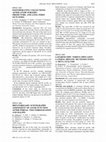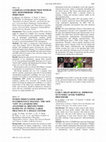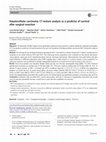Papers by Daniele Sommacale

Annals of Hepato-Biliary-Pancreatic Surgery, 2021
Backgrounds/Aims: Pancreaticoduodenectomy (PD) is the gold standard for the treatment of periampu... more Backgrounds/Aims: Pancreaticoduodenectomy (PD) is the gold standard for the treatment of periampullary tumors. Many specialized centers have adopted the totally laparoscopic or hybrid laparoscopic PD (LPD). However, this procedure has not yet been standardized and serious debate is taking place towards its safety and feasibility. Herein, we report our recent experience whit hybrid-LPD. Methods: During 2019 in our department 56 PD were performed and 21 (37.5%) underwent hybrid-LPD. We have retrospectively reviewed the short-term outcomes of these patients. Results: Main indication was pancreatic adenocarcinoma (71,4%). The median operative time and intraoperative blood loss were respectively 425 min (range, 226 to 576) and 317 ml (range 60 to 800 ml). Conversion to an open procedure was required in 4 patients (19%): 2 with suspected vein involvement, 1 for mesenteric panniculitis and 1 for biliary injury. The post-operative complication rate was 42.8% (9/21). Regarding post-operative pancreatic fistula, three patients (14.2%) had grade B and 1 grade C (4.7%). Median length of hospital stay was 14 days (range 9-23) and 90-days mortality was 4.7%. The mean number of harvested lymph nodes was 17.7 (range 12 to 26). The rate of margins R0 was 80%; R1 >0<1 mm was 10.5% and R1 0 mm was 9.5%. Conclusions: Hydrid-LPD is safe and feasible. Careful patient selection and increasing experience can reduce the risk of post-operative complications.
European journal of surgical oncology : the journal of the European Society of Surgical Oncology and the British Association of Surgical Oncology, 2021

Journal de Chirurgie Viscérale, 2021
Introduction L’approche anterieure (AA) lors de l’hepatectomie droite (HD) pour carcinome hepatoc... more Introduction L’approche anterieure (AA) lors de l’hepatectomie droite (HD) pour carcinome hepatocellulaire (CHC) a ete evaluee par plusieurs etudes asiatiques avec un benefice oncologique demontre compare a l’approche classique (AC). Le but de cette etude etait de comparer les resultats oncologiques de ces deux approches dans cette indication, dans une cohorte occidentale. Methode C’est une etude retrospective bicentrique Francaise avec un appariement par score de propension (PSM). L’objectif principal etait de comparer les resultats des deux approches en termes de survie sans recidive (SSR), de recidive precoce ( Resultats Parmi les 140 patients inclus, l’analyse de survie a ete realisee chez 114 patients (AC : 60 patients ; AA : 54 patients). Aucune difference significative n’a ete retrouvee en matiere de SSR (HR = 1,1, IC95 % : 0,62–1,9, p = 0,77), de SG (HR = 1,2, IC95 % : 0,54–2,6, p = 0,66) et de recidive precoce (AA : 33,3 % ; CA : 46,7 % ; p = 0,14). Apres PSM 1:1, 32 patien...
Journal of Hepatology, 2018

American Journal of Men's Health, 2020
Erectile dysfunction (ED) is one of the main functional complications of surgical resections of t... more Erectile dysfunction (ED) is one of the main functional complications of surgical resections of the rectum due to rectal cancers or inflammatory bowel disease (IBD). The present systematic review aimed at revising ED management strategies applied after rectal resections and their efficacy in terms of improvement of the International Index of Erectile Function (IIEF) score. A literature search was conducted on Medline, EMBASE, Scopus, and Cochrane databases by two independent reviewers following the PRISMA guidelines. Randomized and nonrandomized controlled trials (RCTs, NRCTs), case-control studies, and case series evaluating medical or surgical therapies for ED diagnosed after rectal surgery for both benign and malignant pathologies were eligible for inclusion. Out of 1028 articles initially identified, only five met the inclusion criteria: two RCTs comparing oral phosphodiesterase type-5 inhibitor (PDE-5i) versus placebo; one NRCT comparing PDE-5i versus PDE-5i + vacuum erection d...

Annals of Laparoscopic and Endoscopic Surgery, 2020
Background: With the widespread application of robotic systems and the increasing number of studi... more Background: With the widespread application of robotic systems and the increasing number of studies comparing robotic right colectomy (RRC) and laparoscopic right colectomy (LRC), there is a need for an up-to-date systemic review and meta-analysis assessing the advantages of this technique. Methods: The systemic review was performed in Medline, Scopus, Embase, Cochrane Oral Health Group Specialized Register and Google Scholar databases searching for studies comparing RRC and LRC, with no date restriction but limited to English and French literature. Two independent reviewers performed data extraction and qualitative synthesis. Random-effects models were used to summarize the risk ratio (RR) and mean differences (MD) with 95% confidence interval (CI). Results: Twenty-six non-randomized clinical trials (NRCTs) and 1 RCT were included. Overall, 2,314 patients underwent RRC and 17,791 LRC. Operative time was significantly longer for RRC with a MD of 45.36 min (95% CI: 31.75-58.97; P<0.00001). Conversion rate was significantly lower in the RRC group with a RR of 0.47 (95% CI: 0.27-0.81; P=0.007, I 2 =33%). Also, the number of harvested lymph node was significantly higher in the RRC group than the LRC group, with a MD of 2.03 (95% CI: 0.45-3.61; P=0.01, I 2 =68%). Estimated blood loss favored RRC, with a MD of −8.68 (95% CI: −17.27 to −0.08; P=0.05, I 2 =46%). There was no difference in the overall complication rate, mortality, anastomotic leakage, and time to first flatus. However, a significantly shorter hospital stay was associated with RRC, with a MD of −0.60 (95% CI: −1.01 to −0.19; P=0.004, I 2 =64%). No quantitative analysis could be performed for oncological outcomes. RRC was associated with significantly higher costs (MD 3,185.50 USD; 95% CI: 720.98-5650.02; P=0.01, I 2 =94%). Conclusions: RRC is a safe procedure that may offer certain advantages over LRC as lower conversion rate, blood loss, hospital stay. However, this should be balanced out with increased operative time and higher costs.

Surgical Endoscopy, 2020
Background The aim of this study was to analyze risk factors of local recurrence (LR) after exclu... more Background The aim of this study was to analyze risk factors of local recurrence (LR) after exclusive laparoscopic thermoablation (TA) with or without associated liver resection. Methods Between 2012 and 2017, among 385 patients who underwent 820 TA in our department, 65 (17%) patients (HCC = 11, LM = 54) had exclusive laparoscopic TA representing 112 lesions (HCC = 17, LM = 95). TA was associated with other procedures in 57% of cases (liver resection 81%). All TA were done without liver clamping. Median tumor size was 1.8 cm [ranges from 0.3 to 4.5], 18% of the lesions were larger than 3 cm in size and 11% close to major liver vessels. Tumors locations were 77.5% in right liver, 36% in S7&S8, and 46% in S7&S8&S4a. Results Mortality was nil and morbidity rate 15.4% including Dindo-Clavien > II grade 3%. The median follow-up was 24 months [0.77-75]. Per lesion LR rate after TA was 18% (n = 19 patients) with a mean time of 7.6 months. Among patients with LR, 18 (95%) could have been retreated successfully (new resection = 11, re-TA = 7). Multivariate analyses revealed that tumor location in S7 alone, S7&S8 and/or S7, S8, or S4a were independent risk factors of LR after TA. Conclusions Exclusive laparoscopic TA is a safe and an effective tool to treat liver malignancies with or without liver resection. Other than classical risk factors, tumor location in upper segments of the liver, are independent risk factors for LR.

HPB, 2019
Background: Robotic surgery is gaining momentum in complex procedures, such as liver resection. T... more Background: Robotic surgery is gaining momentum in complex procedures, such as liver resection. The technique offers several advantages over conventional laparoscopy such as wristed instruments and a magnified 3-dimensional view of the operative field. The improved dexterity makes the robotic system particularly suited for liver resections that require non-linear manipulation, such as curved parenchymal transection, hilar dissection and resection of the posterosuperior segments. Therefore, the use of the robotic system might enable a larger proportion of liver resections to be performed minimally invasive. Aim: To present a video of a robot-assisted laparoscopic liver resection of segment 7. Methods: Between August 2014 and September 2016 20 patients underwent robot-assisted laparoscopic liver resection at our institution, from which 10 underwent a resection of a posterosuperior segment. The video demonstrates a resection of segment 7 in a 63 eold male patient with a neuroendocrine tumor. Results: The procedure was completed fully laparoscopic using 4 trans abdominal trocars. The tumor was removed radically. Postoperatively, the patient recovered quickly and did not suffer from any complications. After 4 days he was discharged from the hospital. Conclusion: Robot-assisted laparoscopic liver resection is safe and feasible in selected patients. The use of the robotic system might be especially advantageous in resections of the posterosuperior segments.

HPB, 2018
Introduction: Postoperative collection (PC) can occur after liver surgery (LS), but little is kno... more Introduction: Postoperative collection (PC) can occur after liver surgery (LS), but little is know on their impact on short and long-term outcomes. The aim of this study was to analyze factors predicting the occurrence of PC, the need of drainage and their impact on oncologic outcomes. Methods:. This prospective, single-center, cohort-study included all patients undergoing LS from 2008 to 2017. A systematic postoperative CT scan was realized on day7. The primary outcome was to determine variables associated with PC, defined as the presence of a fluid collection, and infected in case of positive bacterial culture. Secondary outcomes were to determine factors predicting drainage requirement, and the impact of infected PC on 5-y overall (OS) survival. Results: We included 254 patients: 45% (n=114) experienced PC. In the multivariate analysis, variables associated to PC occurrence were BMI (25-30=OR1.

HPB, 2018
Introduction: Total vascular exclusion (TVE) of the liver might be required for complex liver res... more Introduction: Total vascular exclusion (TVE) of the liver might be required for complex liver resection. Standard TVE is contraindicated in some situations harboring a high risk of prolonged normothermic ischemia related morbidity. In situ hypothermic portal perfusion (HPP) can be used to overcome prolonged TVE consequences. Methods: This study is a prospective observational case series from January 2012 to December 2016, including patients with malignant tumors involving the vena cava and/or the hepatocaval confluence. Two surgical techniques were used: standard TVE with HPP and venovenous bypass and HPP with preservation of the caval flow using a temporary porto-caval shunt. Results: During the study period, 443 liver resections were performed in our department. Among them, fourteen (3.1%) were performed using HPP. Mean age was 55 years. Twelve (86%) patients had underlying liver disease. Mean tumor size was 87 mm (40-170mm). Mean operative time was 470 mn (360-580mn). Vascular reconstruction was performed in 4 (28.6%) patients. The 90-day mortality rate was 7.1% (1 patient). Four (28.6%) patients experienced grade III of Clavien-Dindo classification postoperative morbidity. No cases of postoperative liver failure or renal insufficiency were observed. Conclusion: HPP should be considered in patients requiring complex liver resections for centrally located tumors involving the hepatocaval confluence as it allows preservation of the future liver remnant function. Meanwhile, such resections should be indicated in selected patients with low comorbidity and good performance status because of a high morbidity rate.
Gastroenterology, 2019
See editorial on page 2130. See Covering the Cover synopsis on 2118. BACKGROUND & AIMS: Chronic h... more See editorial on page 2130. See Covering the Cover synopsis on 2118. BACKGROUND & AIMS: Chronic hepatitis C virus (HCV) infection is an important risk factor for hepatocellular carcinoma (HCC). Despite effective antiviral therapies, the risk for HCC is decreased but not eliminated after a sustained virologic response (SVR) to direct-acting antiviral (DAA) agents, and the risk is higher in patients with advanced fibrosis. We investigated HCV-induced epigenetic alterations that might affect risk for HCC after DAA treatment in patients and mice

European Radiology, 2018
Objectives To determine whether image texture parameters analysed on pre-operative contrast-enhan... more Objectives To determine whether image texture parameters analysed on pre-operative contrast-enhanced computed tomography (CT) can predict overall survival and recurrence-free survival in patients with hepatocellular carcinoma (HCC) treated by surgical resection. Methods We retrospectively included all patients operated for HCC who had liver contrast-enhanced CT within 3 months prior to treatment in our centre between 2010 and 2015. The following texture parameters were evaluated on late-arterial and portalvenous phases: mean grey-level, standard deviation, kurtosis, skewness and entropy. Measurements were made before and after spatial filtration at different anatomical scales (SSF) ranging from 2 (fine texture) to 6 (coarse texture). Lasso penalised Cox regression analyses were performed to identify independent predictors of overall survival and recurrence-free survival. Results Forty-seven patients were included. Median follow-up time was 345 days (interquartile range [IQR], 176-569). Nineteen patients had a recurrence at a median time of 190 days (IQR, 141-274) and 13 died at a median time of 274 days (IQR, 96-411). At arterial CT phase, kurtosis at SSF = 4 (hazard ratio [95% confidence interval] = 3.23 [1.35-7.71] p = 0.0084) was independent predictor of overall survival. At portal-venous phase, skewness without filtration (HR [CI 95%] = 353.44 [1.31-95102.23], p = 0.039), at SSF2 scale (HR [CI 95%] = 438.73 [2.44-78968.25], p = 0.022) and SSF3 (HR [CI 95%] = 14.43 [1.38-150.51], p = 0.026) were independently associated with overall survival. No textural feature was identified as predictor of recurrence-free survival. Conclusions In patients with resectable HCC, portal venous phase-derived CT skewness is significantly associated with overall survival and may potentially become a useful tool to select the best candidates for resection. Key Points • HCC heterogeneity as evaluated by texture analysis of contrast-enhanced CT images may predict overall survival in patients treated by surgical resection. • Among texture parameters, skewness assessed at different anatomical scales at portal-venous phase CT is an independent predictor of overall survival after resection. • In patients with HCC, CT texture analysis may have the potential to become a useful tool to select the best candidates for resection.
HepatoBiliary Surgery and Nutrition, 2017
HPB, 2016
Conclusions: This study identified a patient group that had considerably favorable patient profil... more Conclusions: This study identified a patient group that had considerably favorable patient profile: private insurance, younger age, fewer cirrhotics, and a lower mean ASA. Despite these factors these patients underwent more lobar resections with shorter operative times, and lower incidences of transfusion, hospitalization and mortality. Laparoscopic hepatic resection has altered the paradigm for the management of benign tumors. Rather than the risk of surgical intervention considerations should now be based on access to care and healthcare economics.

Transplant International, 2013
Hepatic artery stenosis (HAS) is a complication that impacts the results of orthotopic liver tran... more Hepatic artery stenosis (HAS) is a complication that impacts the results of orthotopic liver transplantation (OLT). Interventional radiological techniques are important therapeutic options for HAS. The aim of this retrospective study was to evaluate the outcome of repeated radiological treatments in recurring HAS after OLT. Of the 941 patients who underwent OLT at our center from January 1998 to September 2010, 48 (5%) were diagnosed with HAS, 37 (77%) of whom underwent transluminal interventional therapy with the placement of an endovascular stent. Success rate, complications, hepatic artery patency and follow-up were reviewed. After stent placement, artery patency was achieved in all patients. Three patients developed complications, including arterial dissection and hematoma. HAS recurrence was observed in 9 patients (24%), and hepatic artery thrombosis (HAT) occurred in 4 (11%). Radiological interventions were repeated 10 times in 8 patients without complications. At a median follow-up of 66 months (range 10-158), hepatic artery patency was observed in 35 cases (94.6%). The 5-year rates for graft and patient survival were 82.3% and 87.7%, respectively. Restenosis may occur in one-third of patients after endovascular treatment for thrombosis and HAS, but the long-term outcomes of iterative radiological treatment for HAS indicate a high rate of success.
Liver Transplantation, 2004
The split-liver technique is an important means to alleviating donor shortage. Its development is... more The split-liver technique is an important means to alleviating donor shortage. Its development is, at least in part, hindered by the risk of biliary complications, particularly when splitting is performed ex situ. We present a simple technique aimed at improving the identification of the biliary anatomy at the hilar level and the safety of the procedure.

Uploads
Papers by Daniele Sommacale